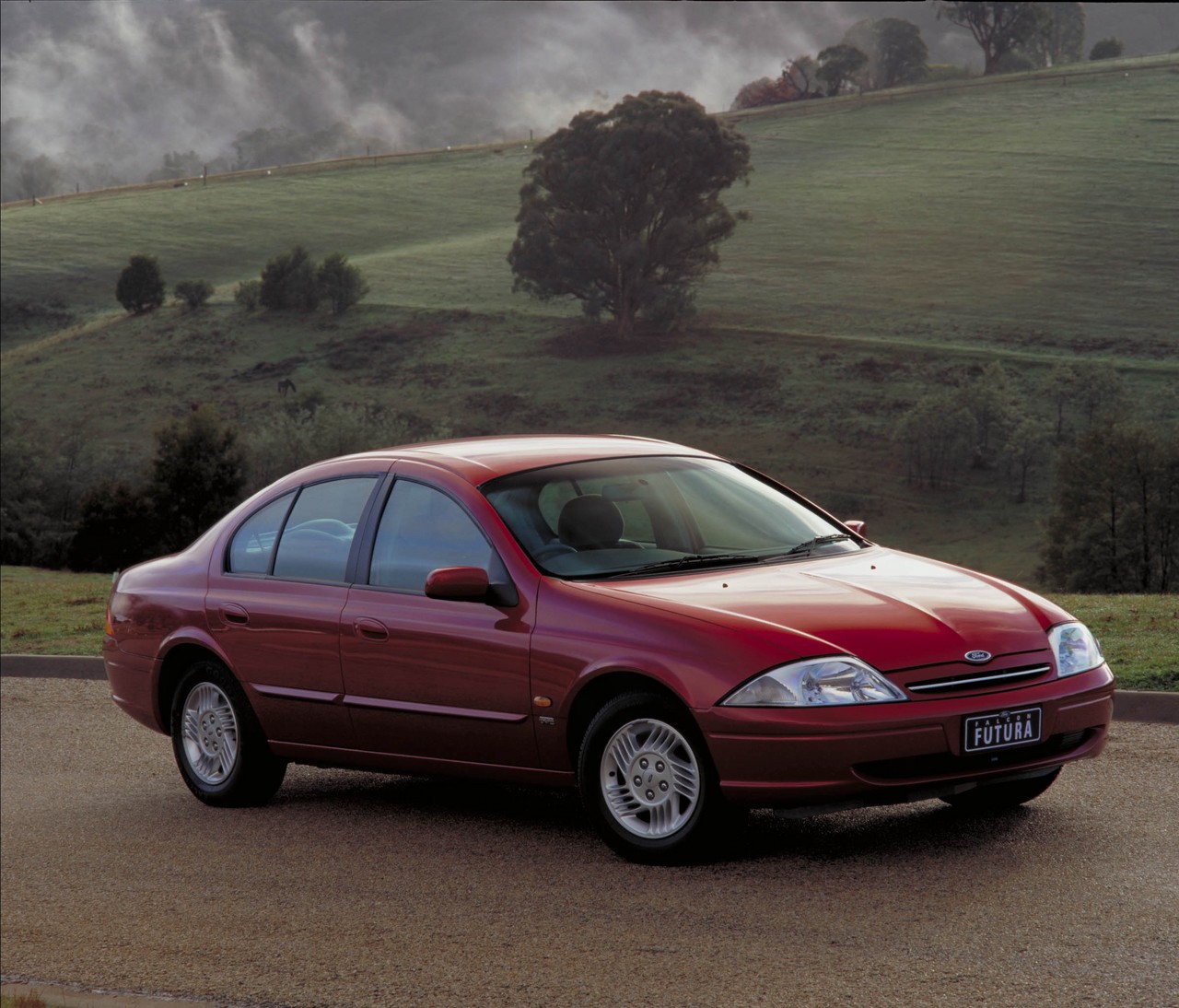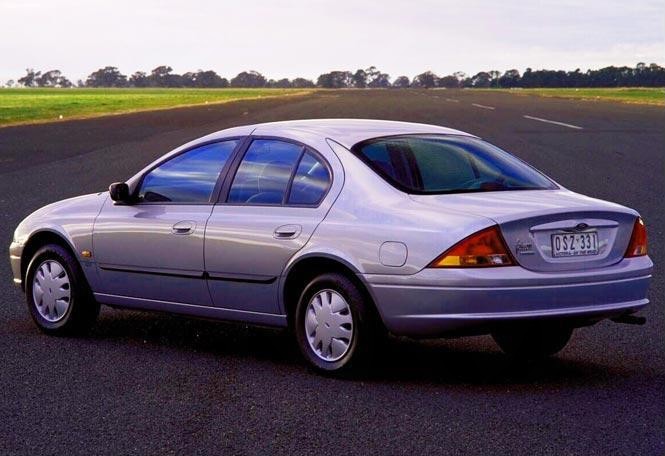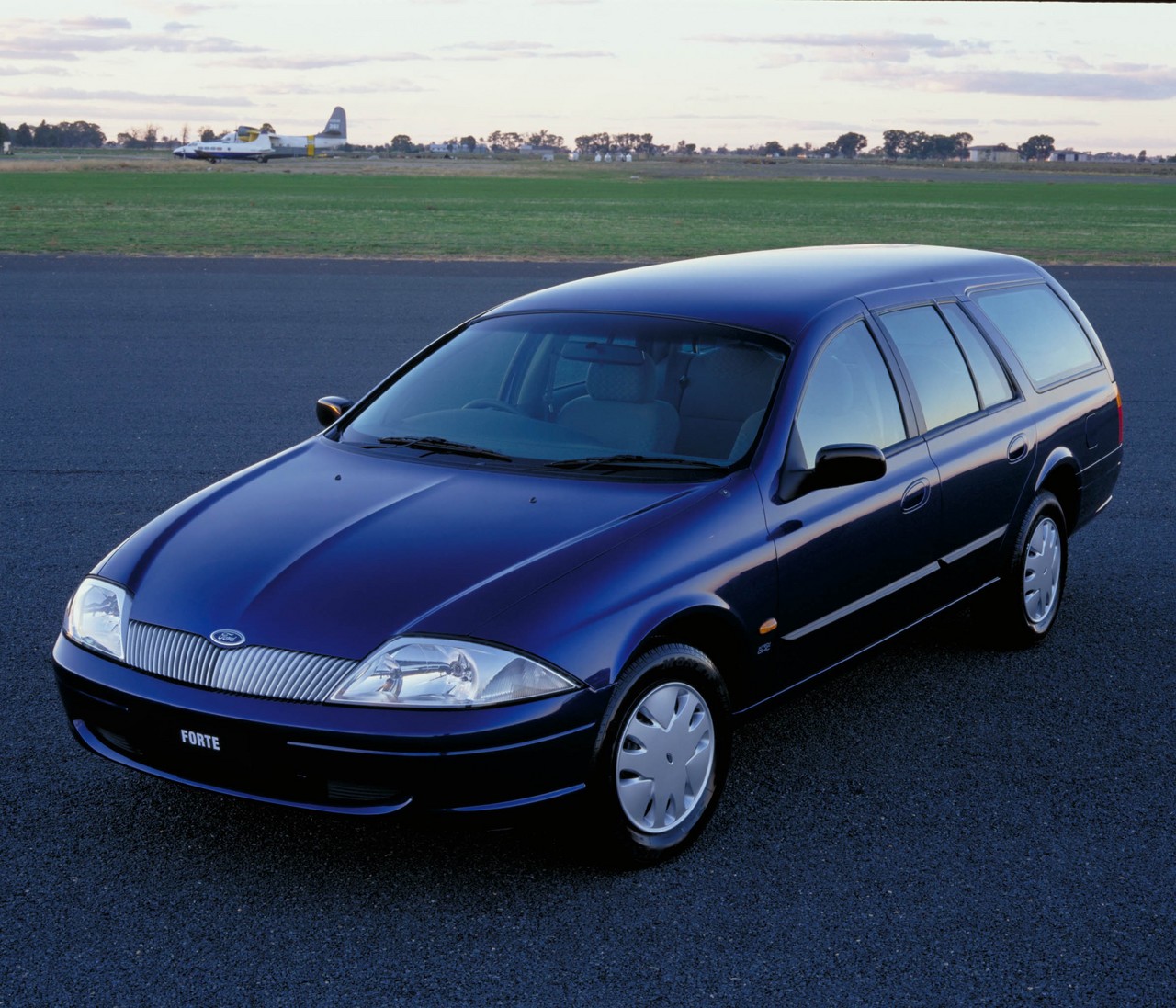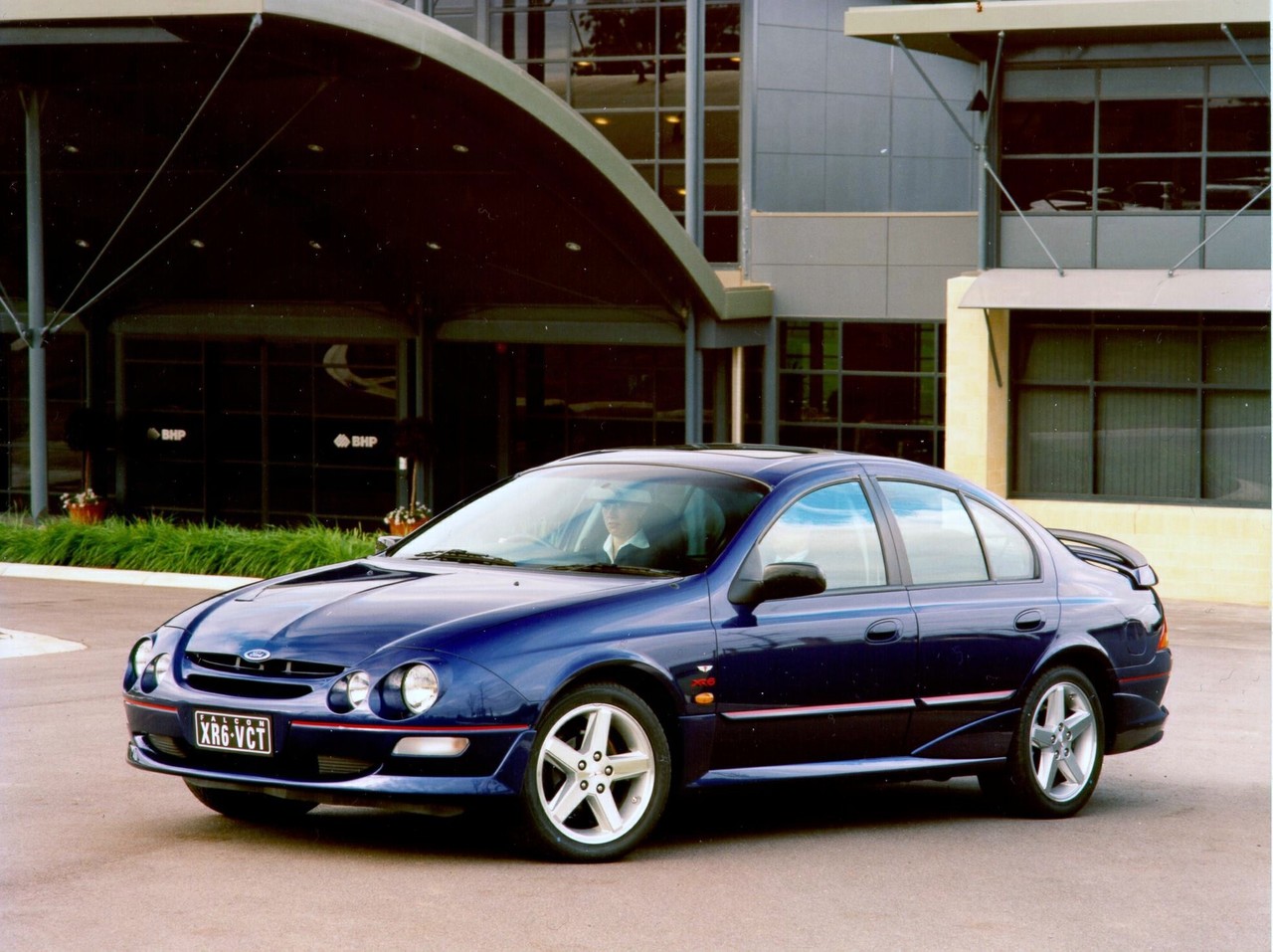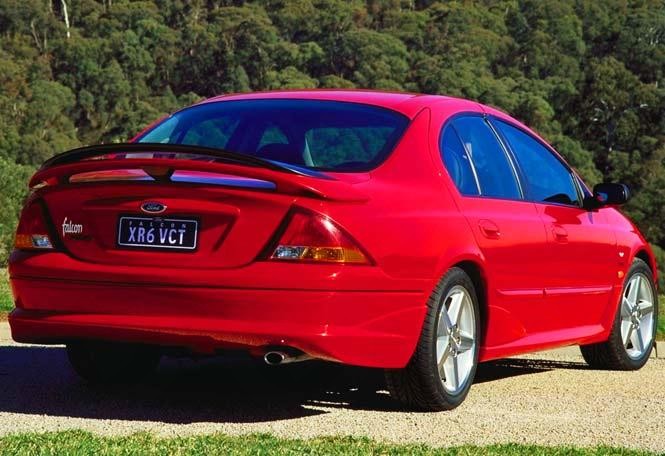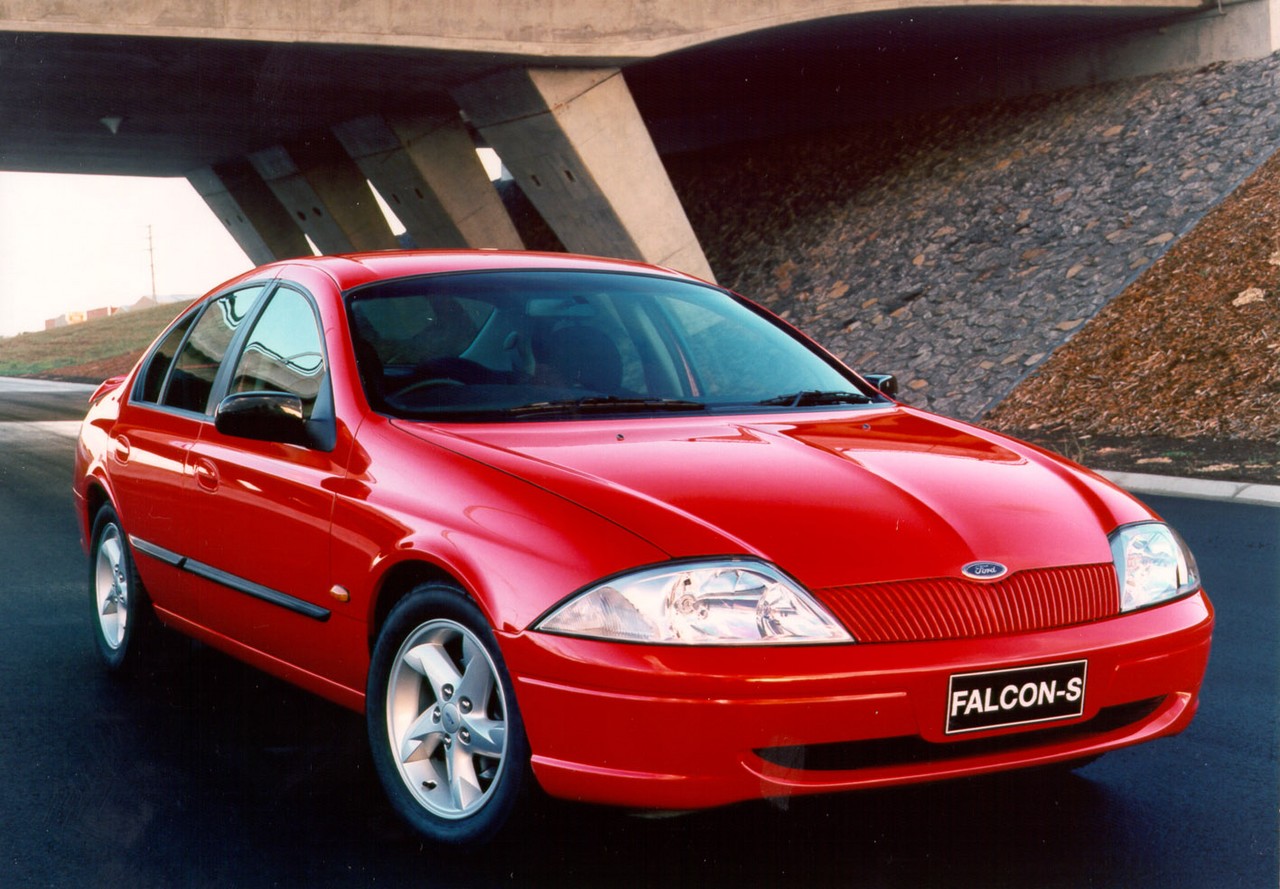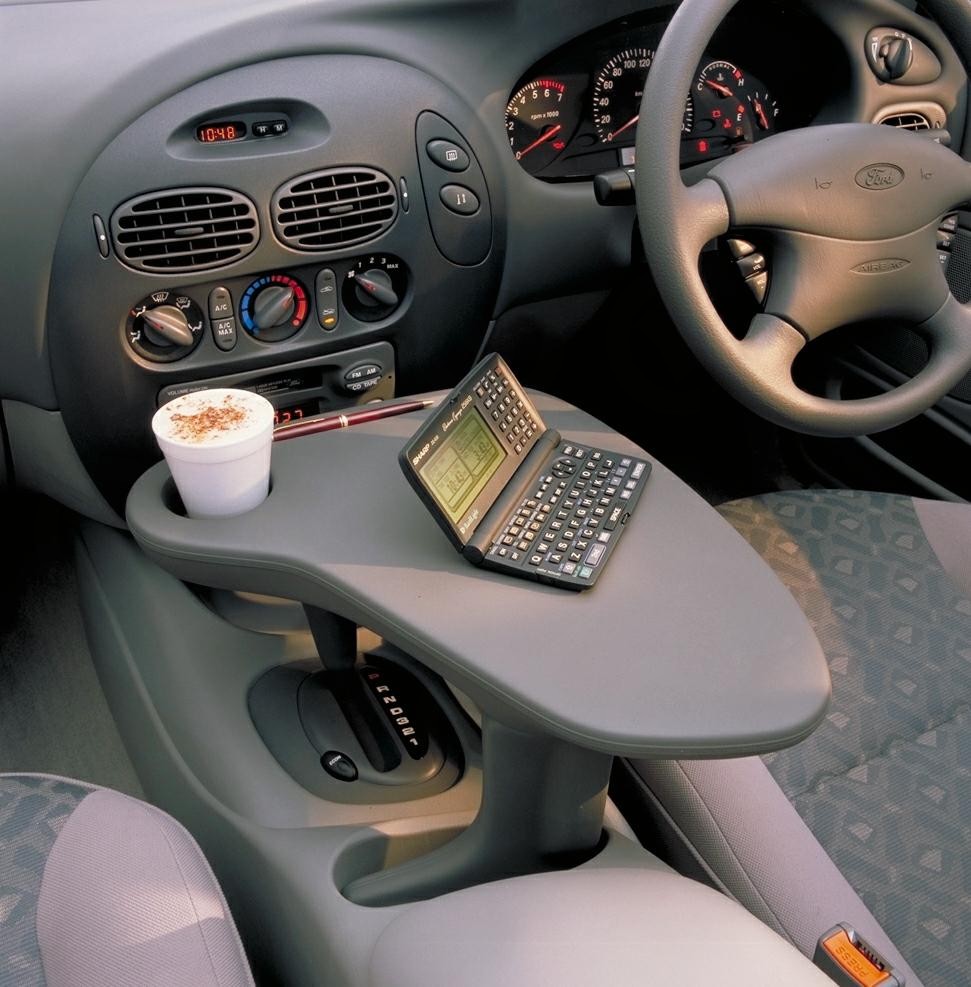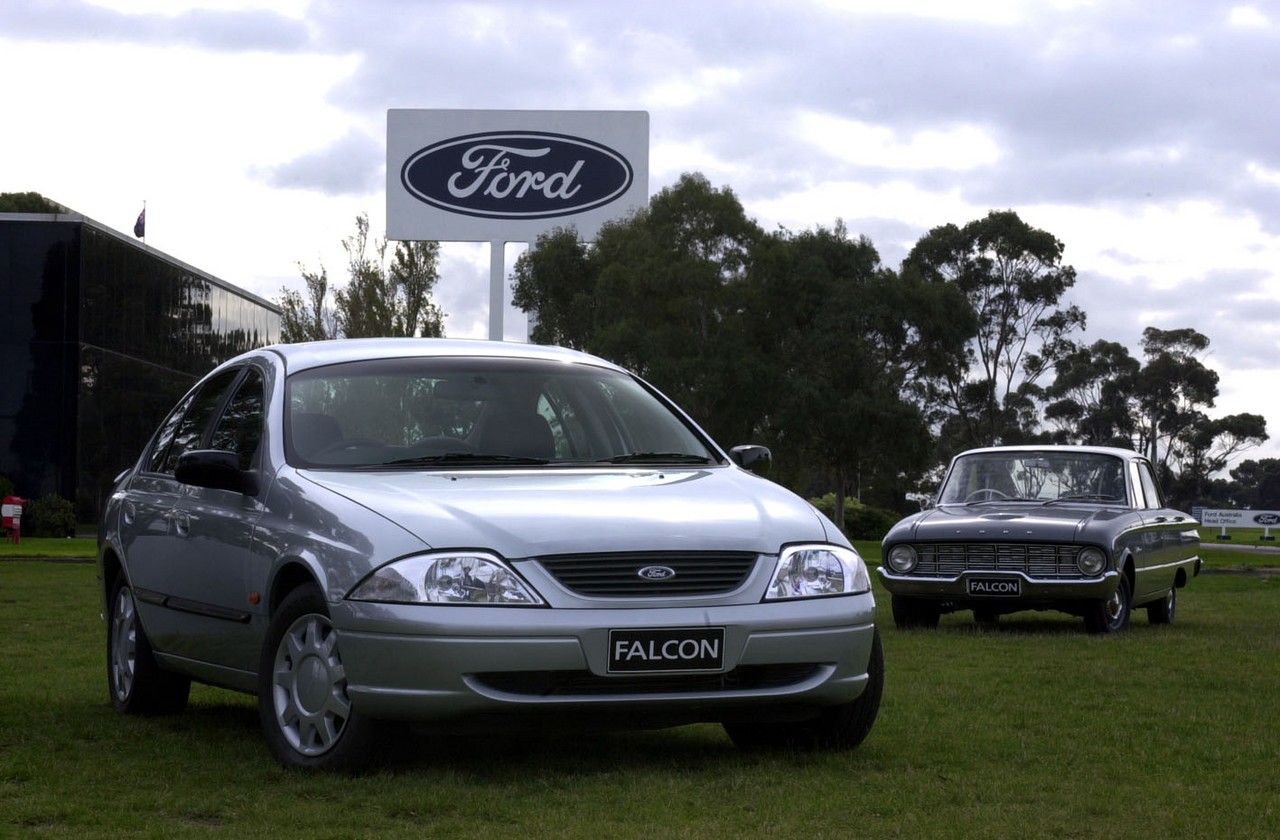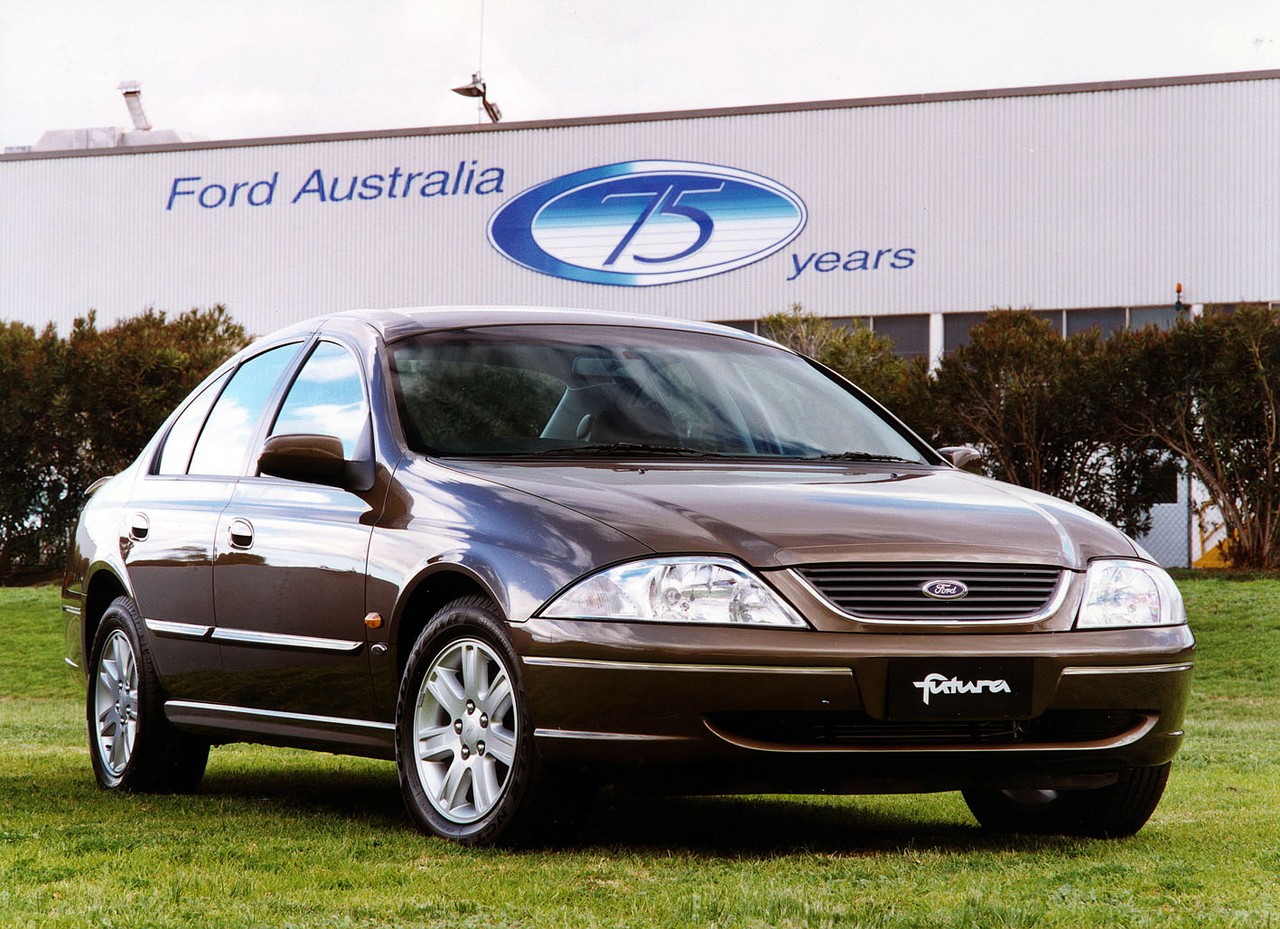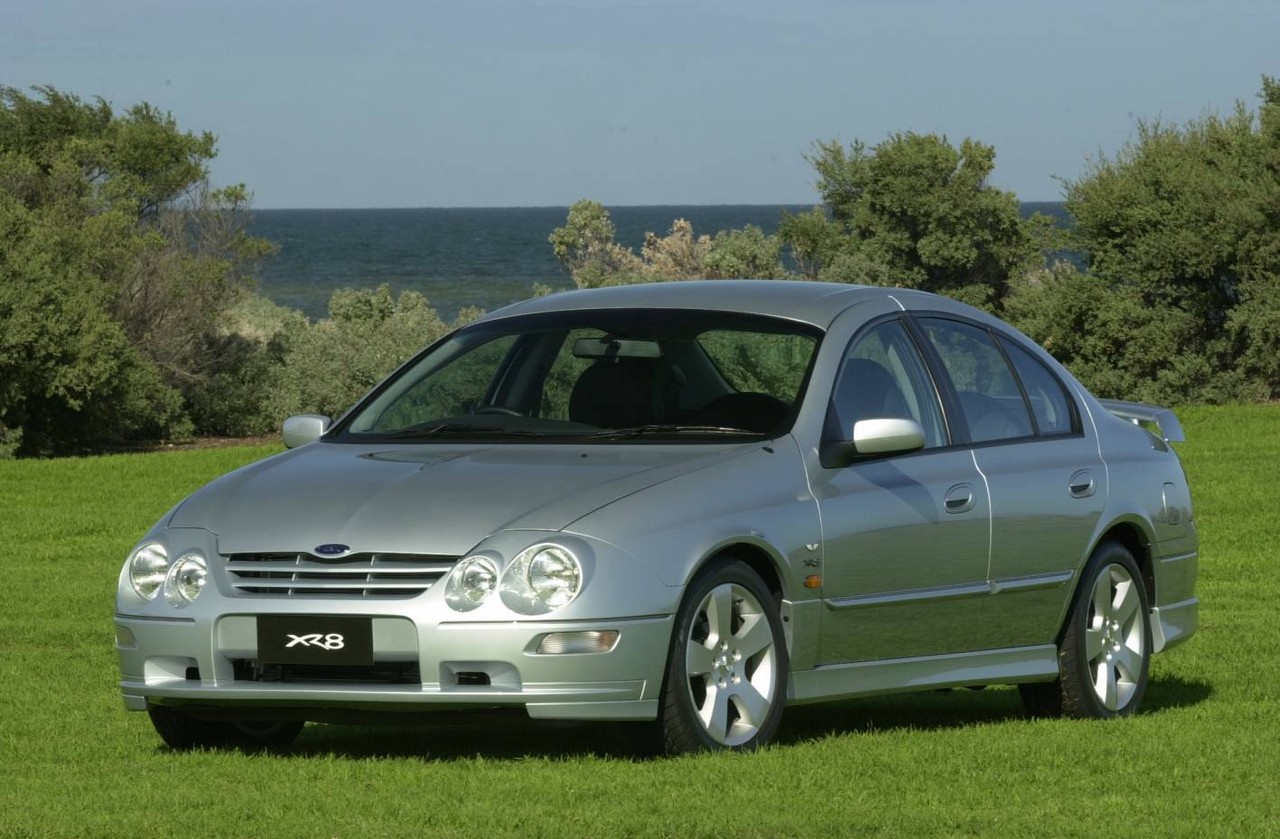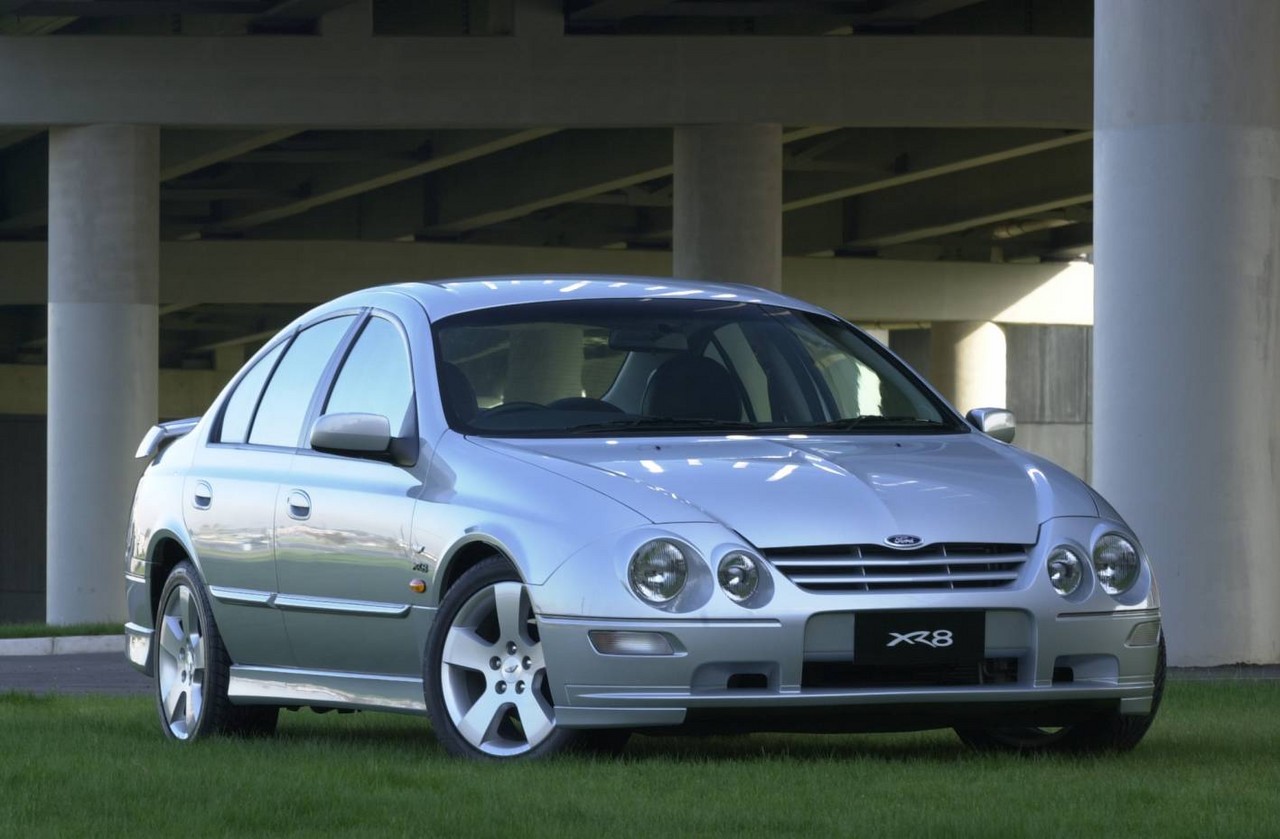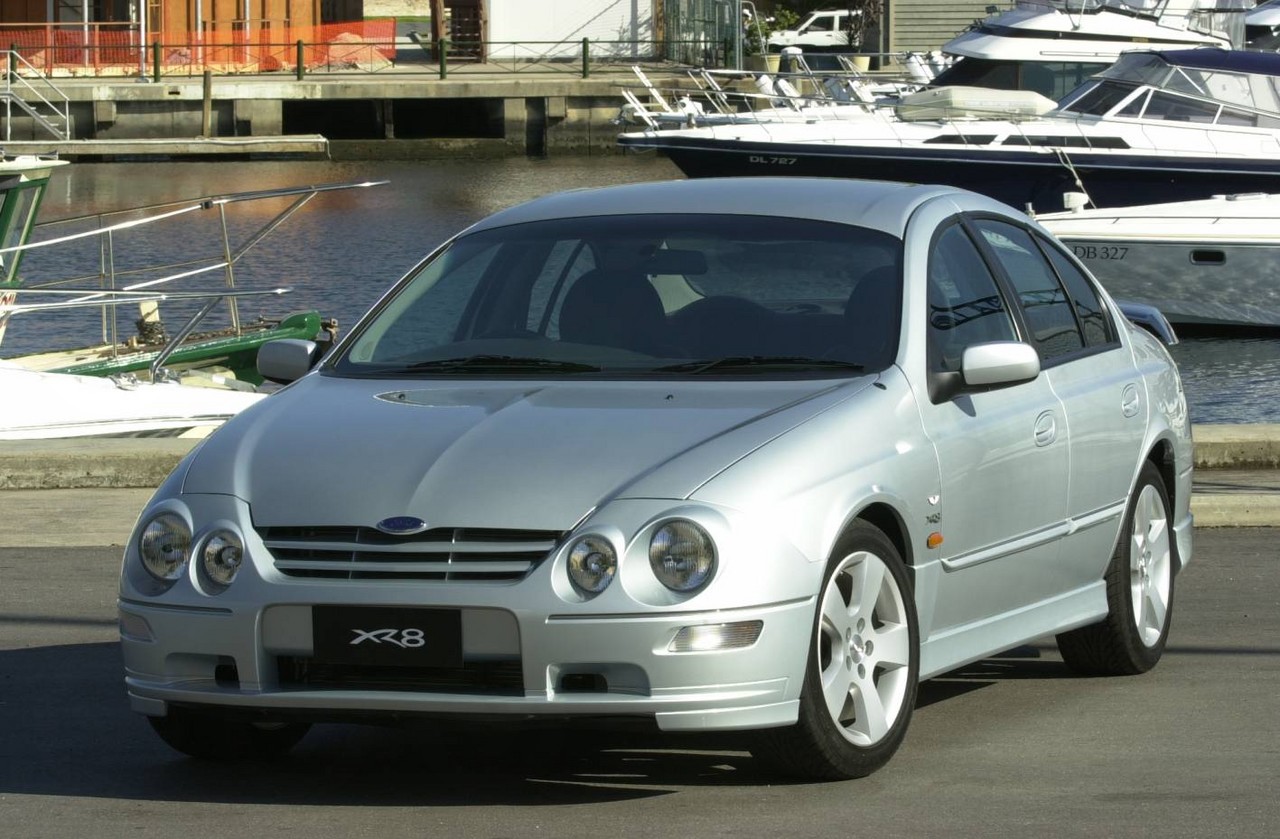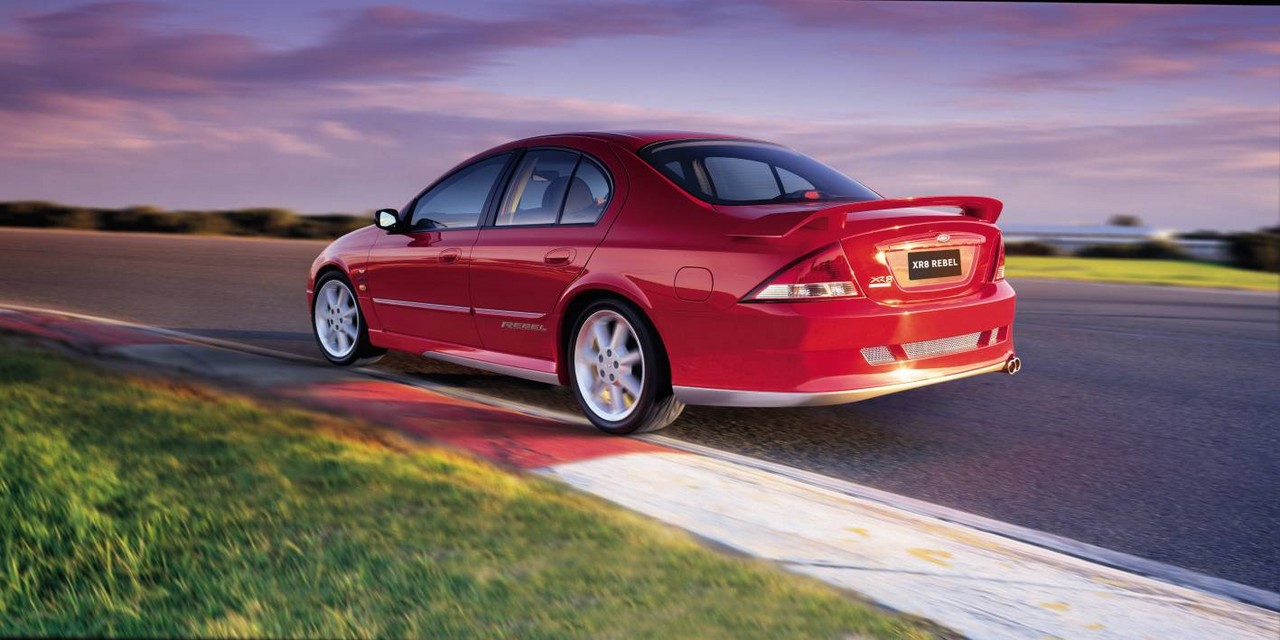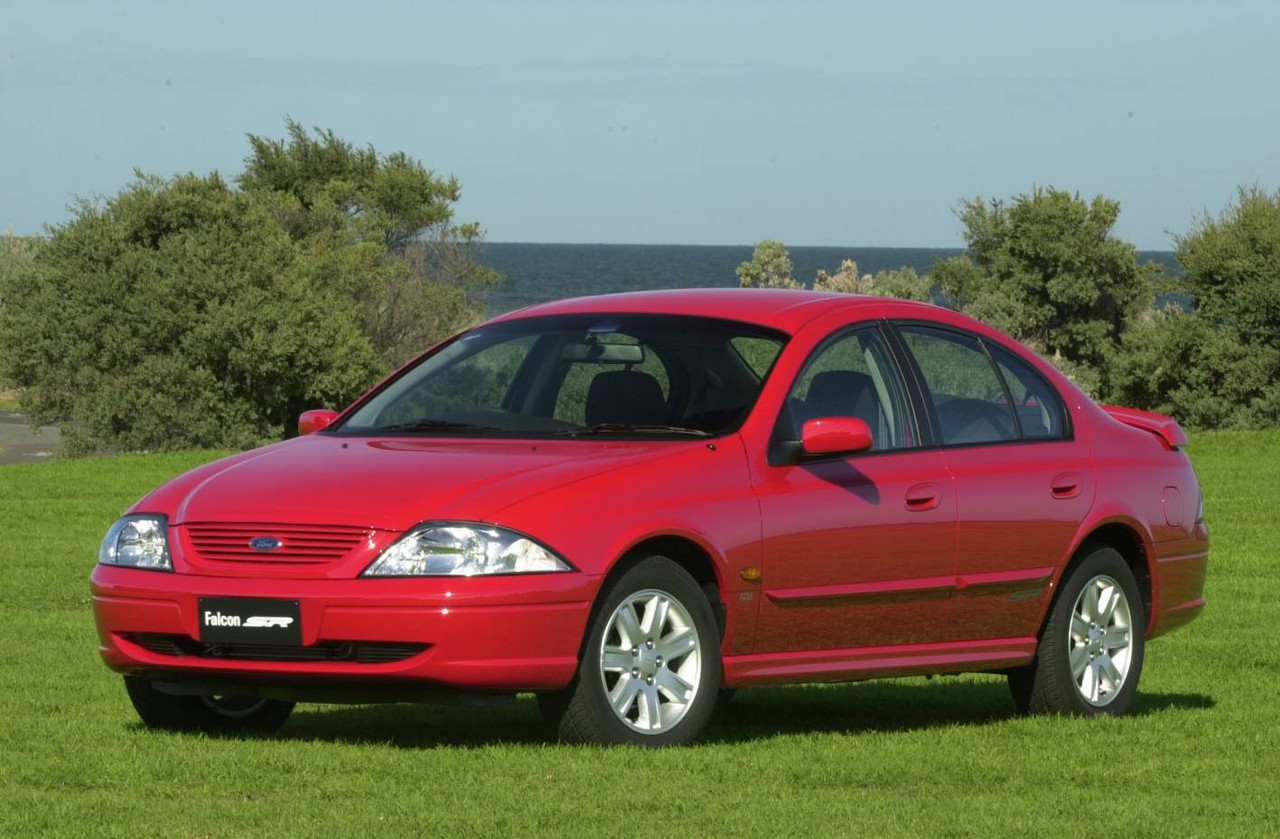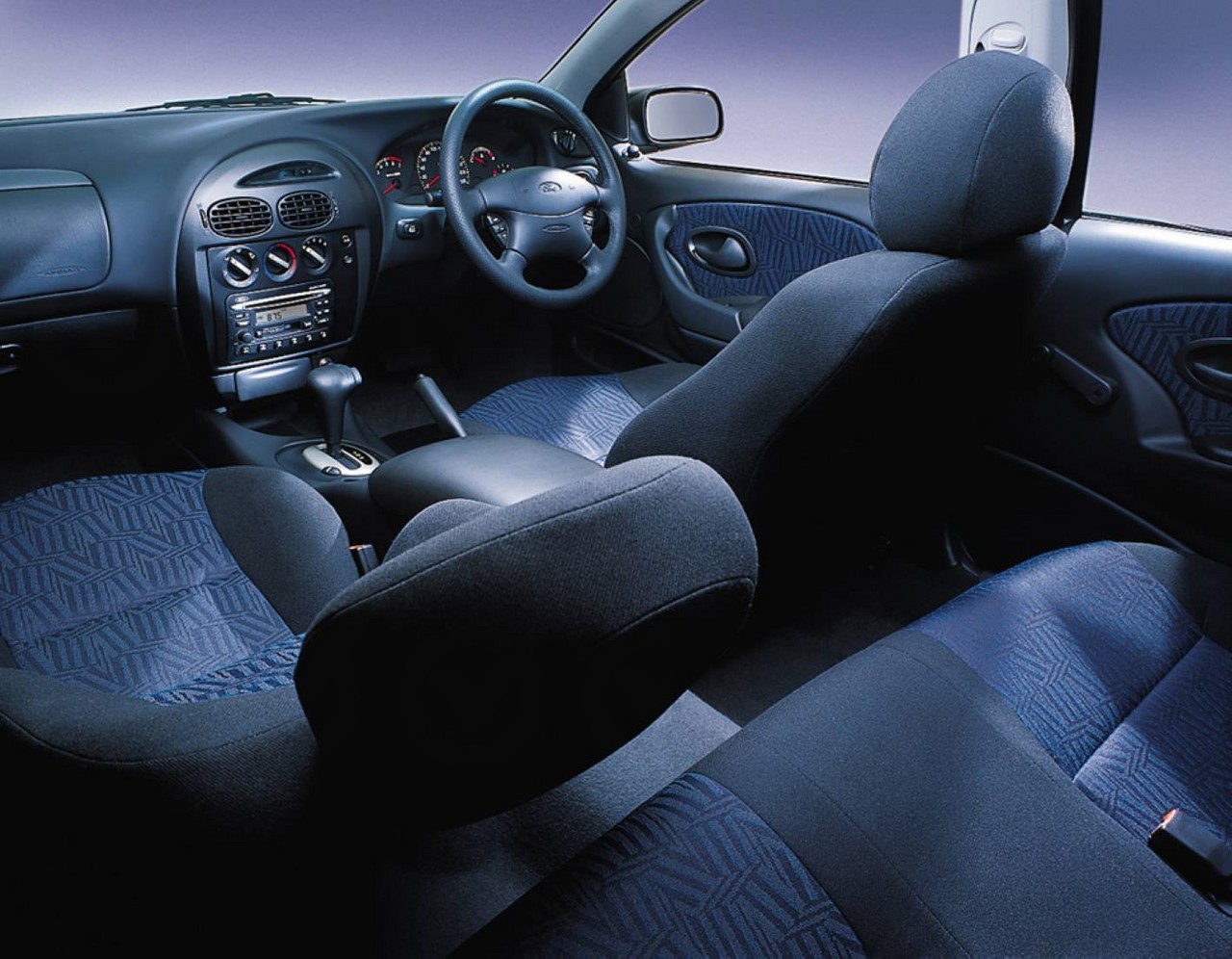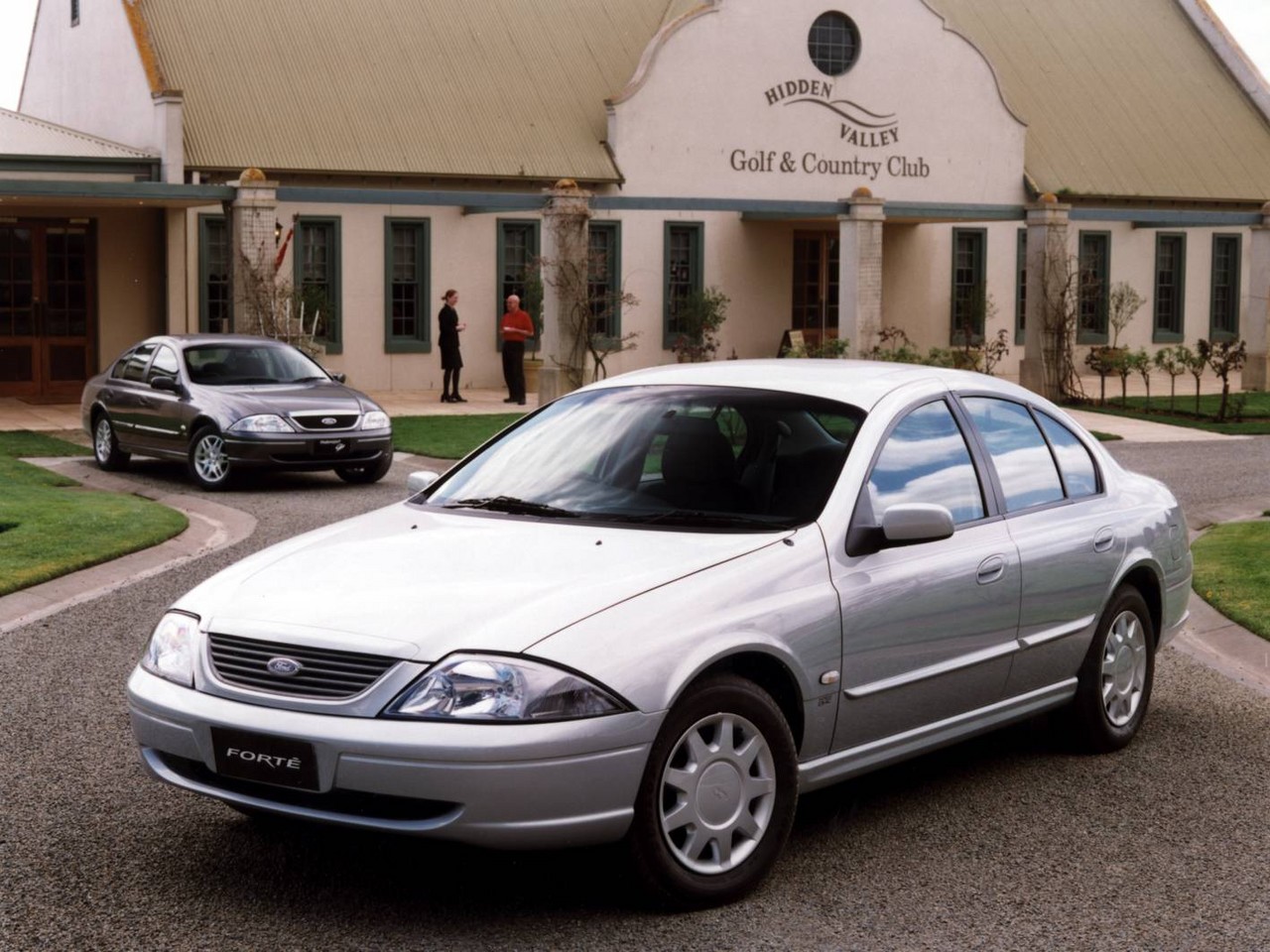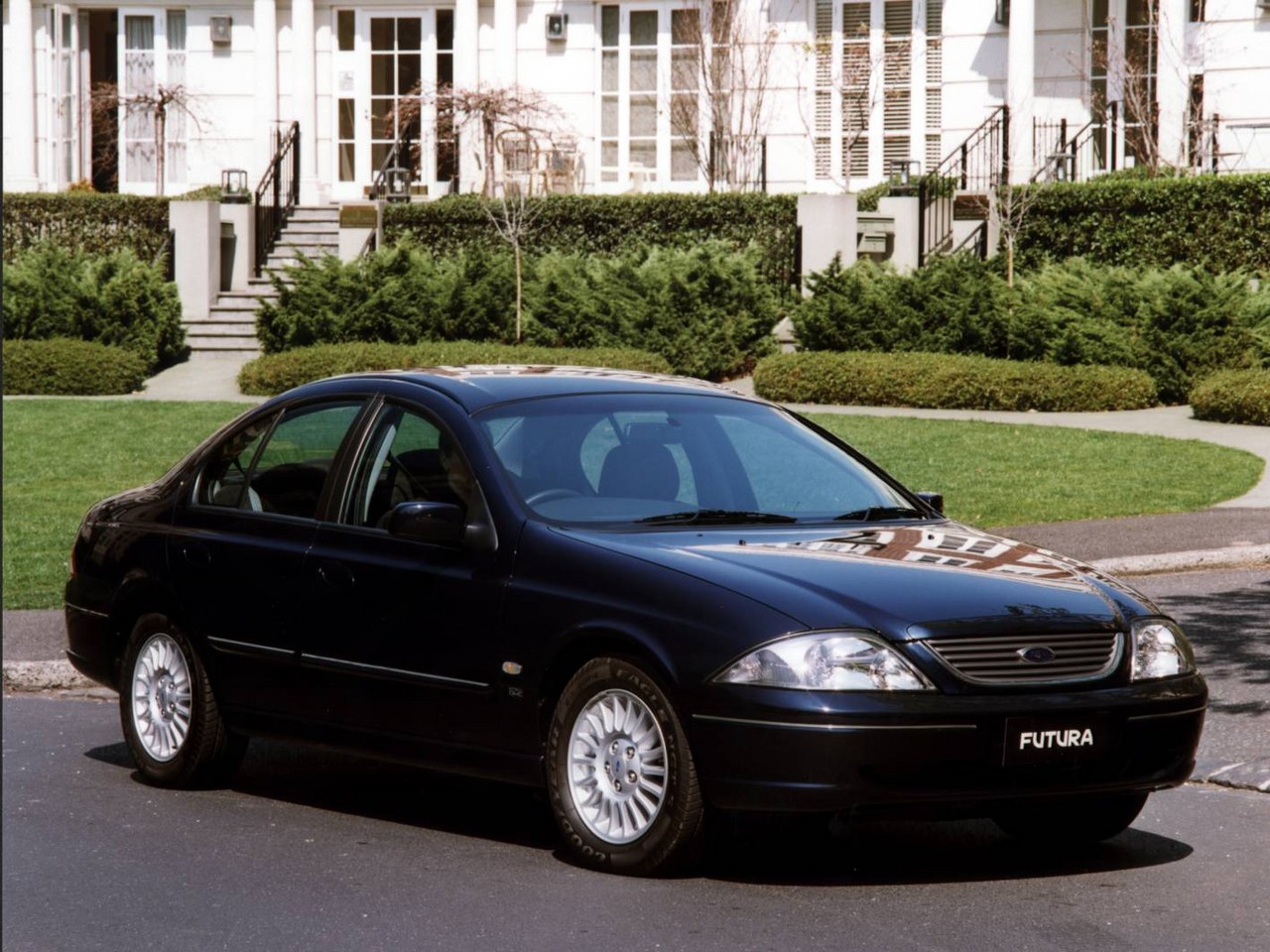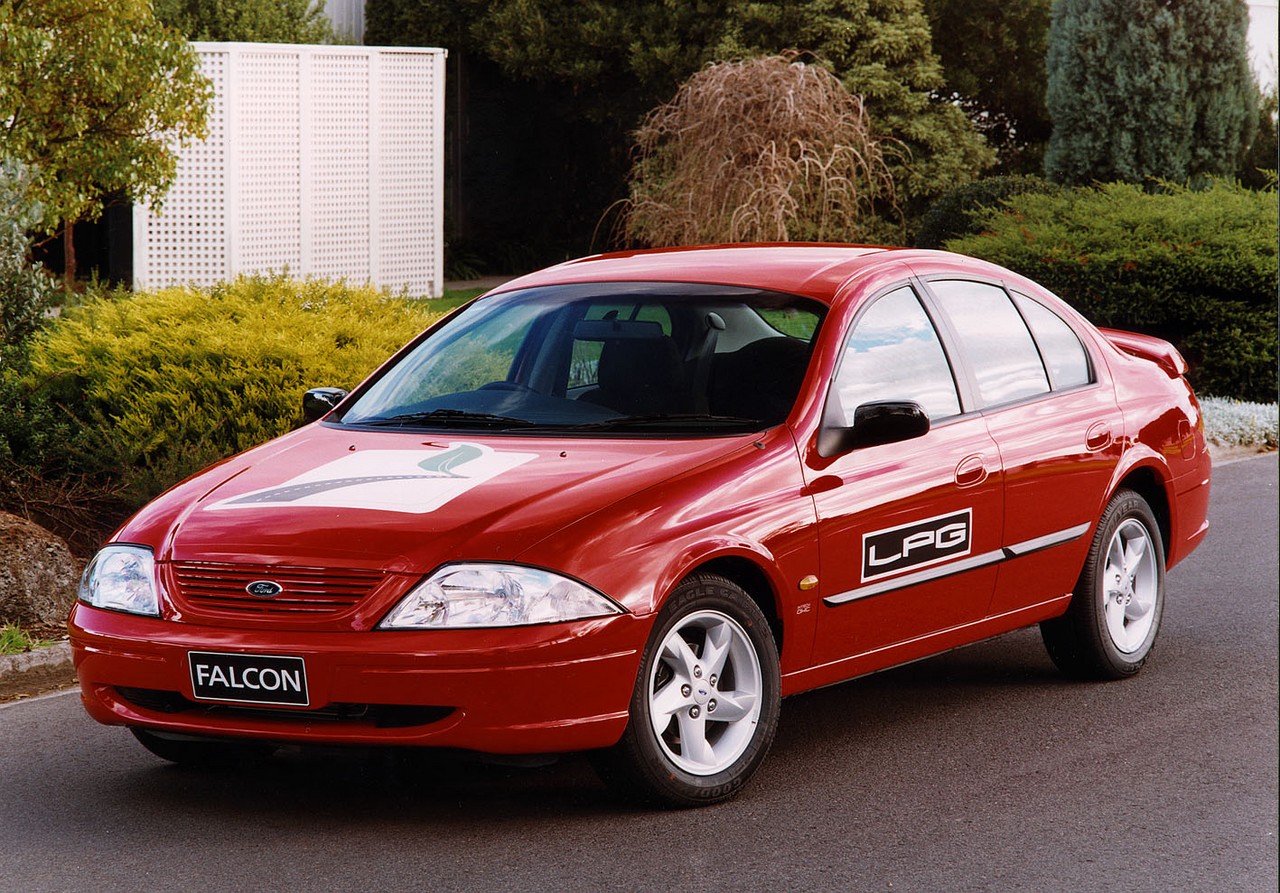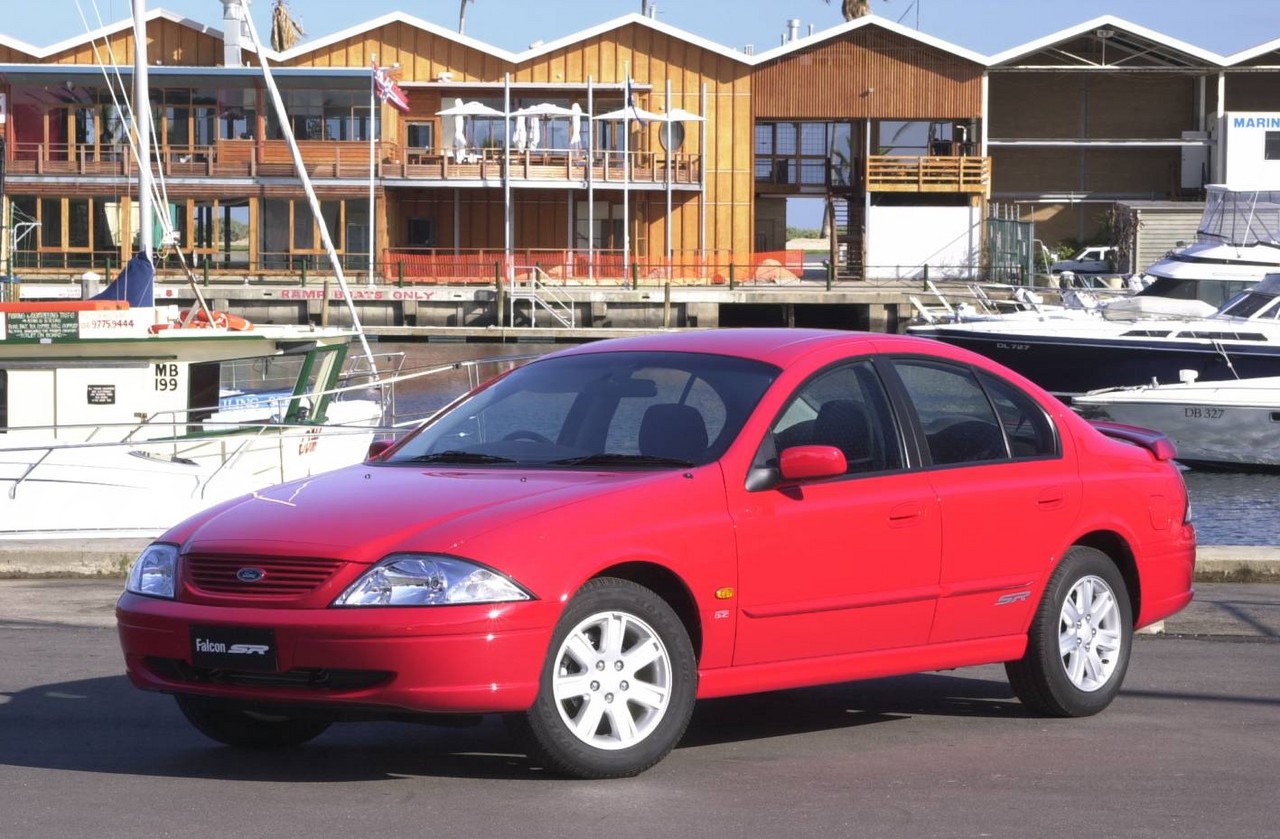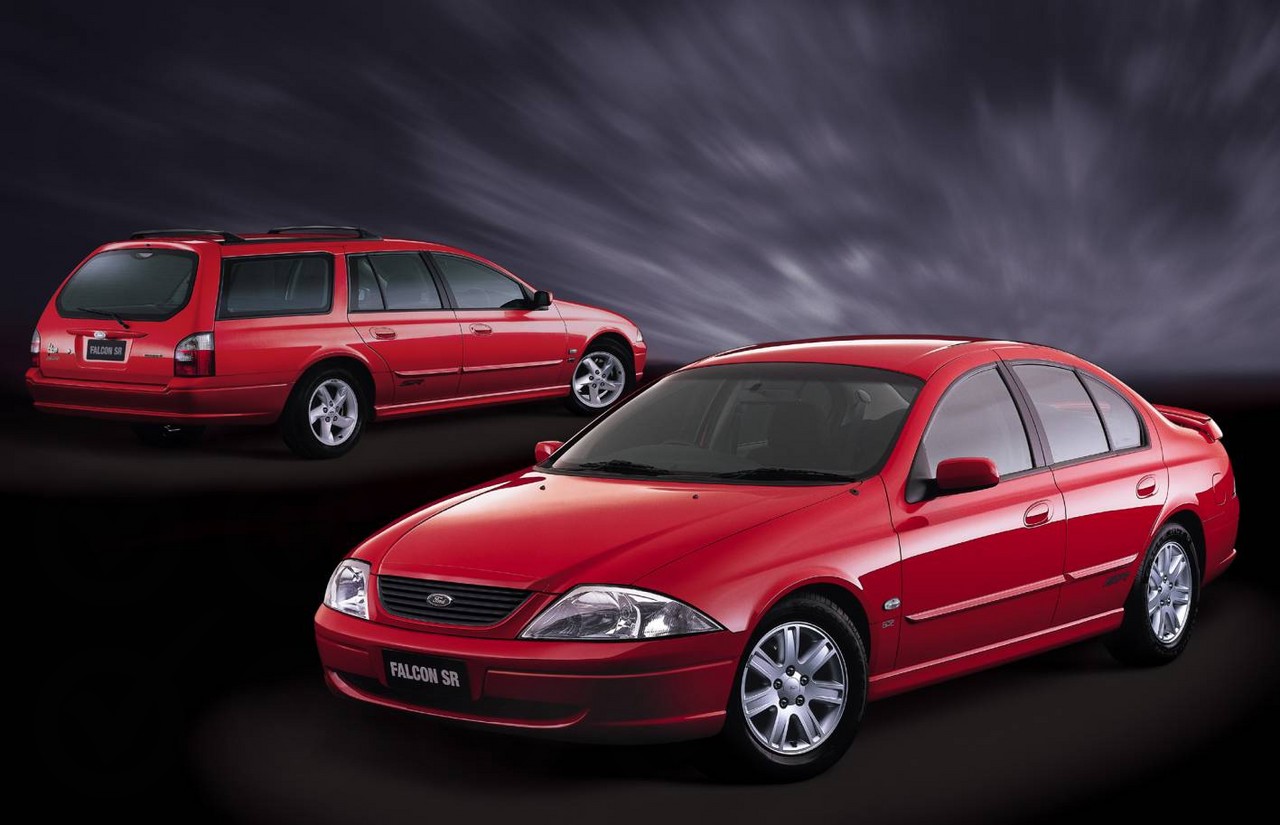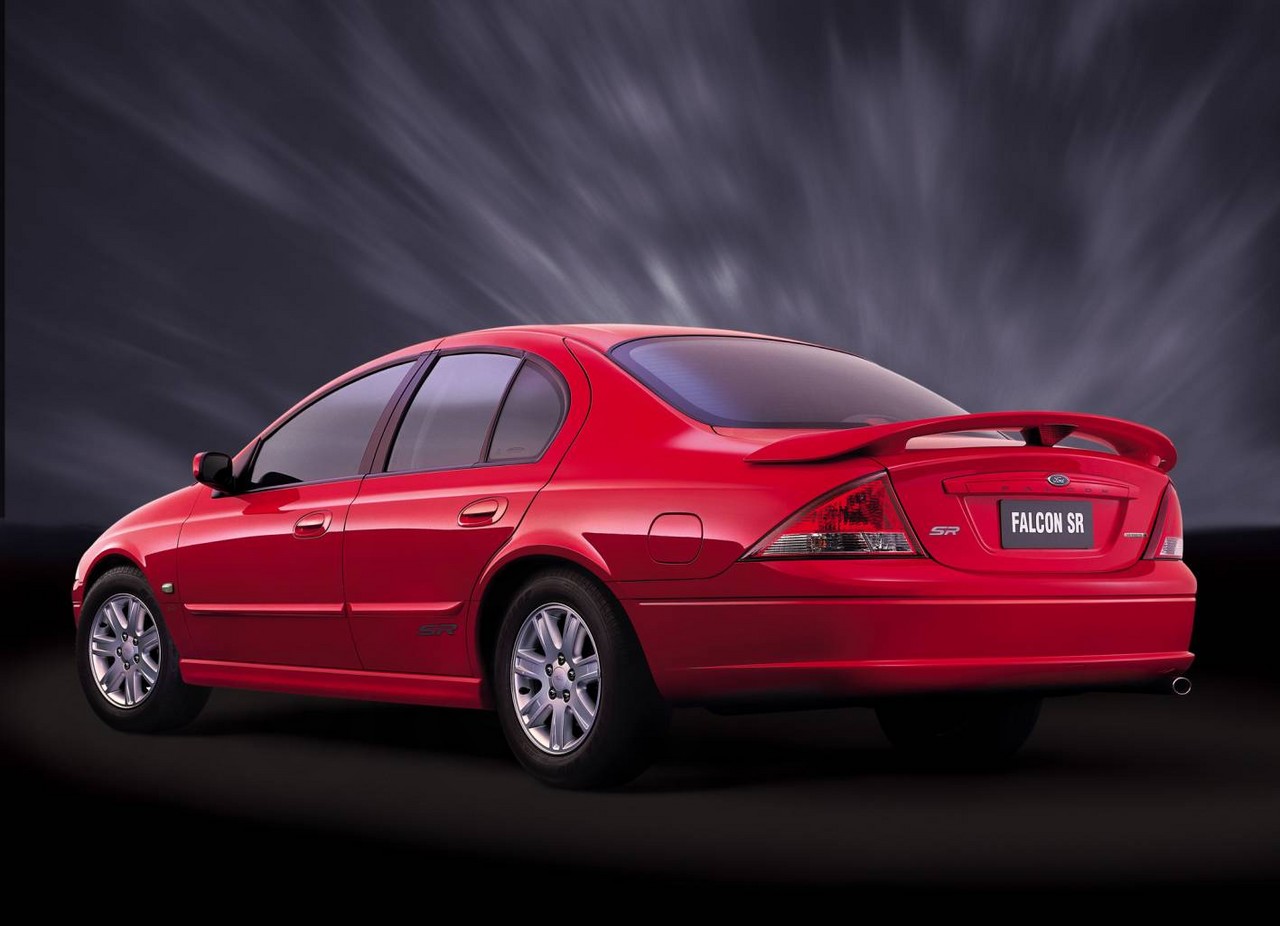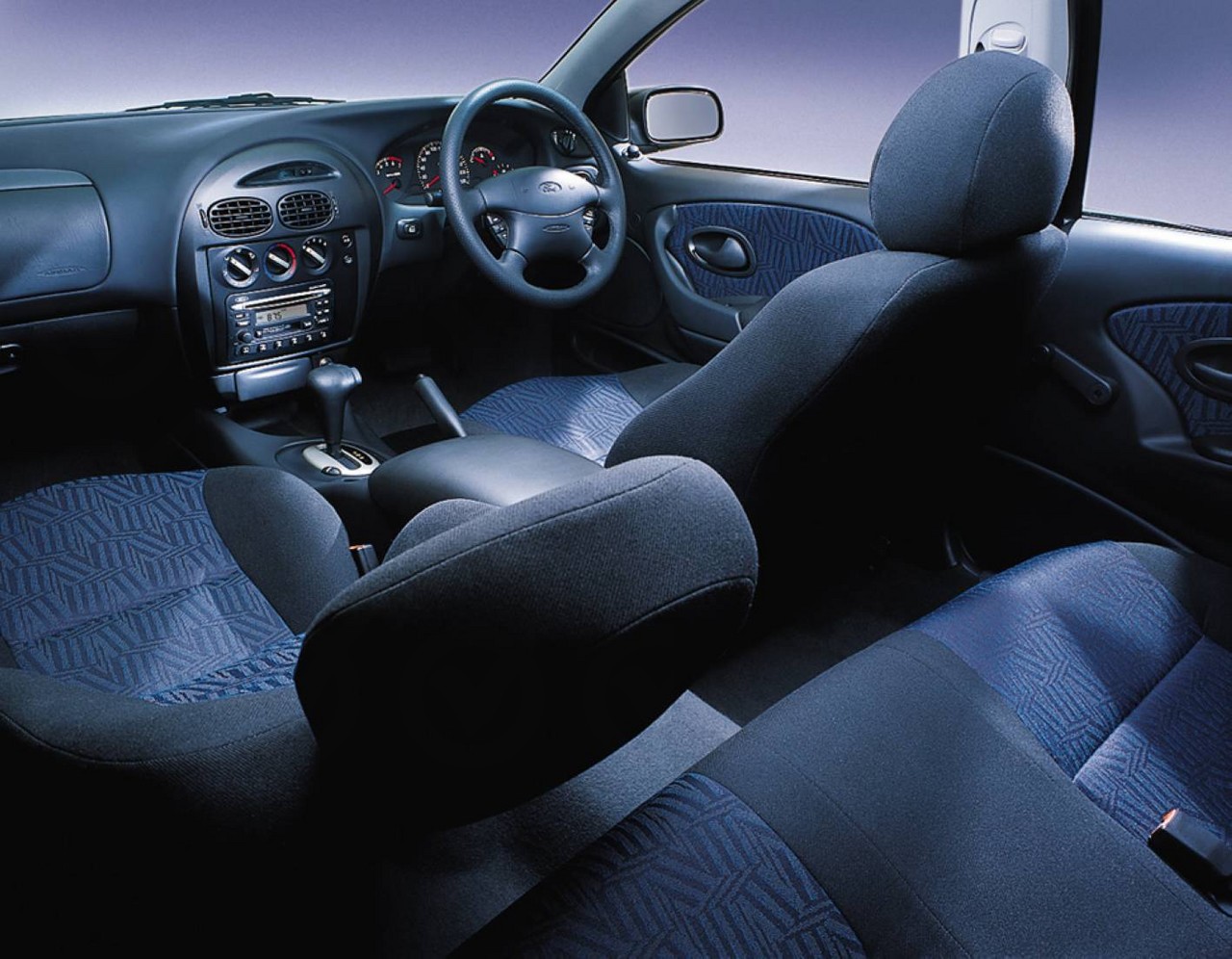
- Responsive 4.0-litre inline six-cylinder engine
- For AU.II and AU.III Falcon, comfortable ride
- Comfortable and supportive front seats
- Folding rear seats and large boot for cargo
- Accurate steering
- Basic live rear axle for entry-level variants
- For AU.I Falcon, suspension lacks compliance while cabin lacks sound insulation
- Awkward rear seat entry and exit
- Dull interior
Review: Ford AU.I Falcon (1998-00)
Overview
Released in September 1998, the Ford AU Series I (AU.I) was available as a large sedan or wagon. Manufactured in Campbellfield, Victoria, the rear-wheel drive Ford AU Falcon was powered by 4.0-litre inline six cylinder and 4.9-litre V8 petrol engines. As per the table below, the AU.I Falcon range initially consisted of Forte, Futura, XR6 and XR8 variants.
Engines: Intech, HP, VCT, LPG and Windsor V8
Of the engines,
- The 4.0-litre Intech six cylinder petrol engine had cast iron block, an alloy cylinder head, sequential electronic fuel injection, a single overhead camshaft (SOHC, chain-driven), two valves per cylinder, an EEC V control unit and a compression ratio of 9.65:1. Compared to its predecessors, the Intech engine had a more rigid block, a new cylinder head, triple-layered steel head gasket, more rigid crankshaft with larger bearings, lighter Teflon-coated pistons, lighter connecting rods, single conical valve springs, a cast aluminium sump (cross-bolted through the main bearing caps), electronic distributorless ignition system (EDIS) and a ‘limp home’ mode which enabled the engine to keep running without coolant fluid. Furthermore, a flexible decoupler between the exhaust manifold and new catalytic converter enabled a lower idle speed of 550 rpm;
- For the Falcon XR6, the 4.0-litre Intech HP (high performance) engine had a unique cylinder head, reshaped inlet port, redesigned exhaust port, ‘open’ combustion chamber (shaped to restrict pre-detonation from hot spot areas), a unique camshaft, higher fuel pressure and recalibrated engine management system;
- The Intech VCT engine added variable cam timing (VCT) and a low back pressure exhaust system. The VCT system used different camshaft profiles to increase torque from 1000-3700 rpm and power beyond 3700 rpm. The VCT module was mounted on the front of the engine and adjusted camshaft timing via an oil pressure-driven helix;
- As an option, the Forte, Futura and Fairmont were available with a dual fuel (i.e. LPG/petrol) system which used had Vialle liquid-to-gas converter, venturi gas/air mixer in the intake tract and used the EEC V control module to manage both the LPG and petrol systems. When starting, the petrol/LPG mix would depend on conditions and, once started, the engine would run solely on LPG. The dual fuel system weighed 85 kg and dual fuel models therefore had modified suspension. For sedan models, the tank was fitted under the rear window shelf, while wagon models had a toroidal tank under the rear floor;
- The 4.9-litre Windsor V8 engine had a cast iron block and cylinder head, two valves per cylinder, EEC V engine management and a compression ratio of 9.1:1. For the AU range, the V8 engines were based on a later generation small block developed for the Ford UT Explorer. Compared to its predecessor, this V8 engine had GT 40 P cylinder heads with centralised platinum spark plugs, a ‘high flow’ fuel intake system, new inlet manifold and distributorless ignition; and,
- For the Falcon XR8, the 4.9-litre V8 engine had a unique camshaft profile, an aluminium trumpet device in the air filter to increase cold air flow, Tickford 4-into-1 headers, a ceramic coated exhaust manifold and a low back pressure exhaust system.
Transmissions
The Falcon was available with four-speed BTR M93LE and M97LE automatic transmissions for the six and eight cylinder models, respectively. The automatic transmissions for the XR6, XR6 VCT and XR8 had an ‘adaptive shift’ feature that would adapt the gear shifting schedule – from one of five strategies – according to driving style. Both six and eight cylinder models were available with five-speed BTR T5 manual transmissions.
For the AU range,
- the automatic transmissions were upgraded with multi-groove C1 (clutch #1) plate friction elements for smoother gear engagements; and,
- the T5 manual transmissions had a new gearset with increased gear tooth contact ratios for reduced gear noise, while an isolator was added to the gearshift offset lever.
Development and dimensions
Developed at a cost of $700 million, the AU Falcon had a new body structure with straightened side rails that were welded together to a beam behind the front bumper. The AU Falcon was around 35 kg lighter than its predecessor, in part due to its 4 kg lighter body structure and 8 kg lighter bake-hardened steel panels. Despite these mass reductions, body lateral bending rigidity increased 20 per cent, longitudinal bending rigidity was up 17.5 per cent and torsional rigidity increased by 13.8 per cent.
Other innovations for the AU Falcon included new headlights for a 30 per cent increase in light projection, triple weather-strip sealing for the doors (previously double weather-strips) and new sound proofing materials – sourced from OrbSeal Australia – which expanded during the paint baking process to fill gaps and cavities more effectively.
Compared to the EL Falcon , the AU Falcon sedan was 11 mm shorter (at 4907 mm), 9 mm wider (1870 mm), 20 mm taller (1481 mm) and had a 2 mm longer wheelbase (2793 mm). Compared to the sedans, the wagons were 151 mm longer (at 5058 mm), 49 mm taller (1530 mm) and the wheelbase was extended by 129 mm (2922 mm).
The AU Falcon sedan and wagon had drag coefficients of 0.295 and 0.341 Cd, respectively.
Suspension
The AU Falcon introduced double-wishbone front suspension as standard for all models, while three different rear suspensions were offered:
- The ‘standard’ Falcon sedans had a live rear axle with unequal length upper and lower longitudinal arms, an anti-roll bar and Watts links pivoting off the differential housing to side rail brackets;
- The Falcon wagon had ‘Wide Trac’ rear suspension which differed in that the shock absorbers were located outboard of the leaf springs and angled towards the front of the car; and,
- The XR6 VCT and XR8 had multi-link, double wishbone independent rear suspension that had adjustable toe links and was isolated via a rear subframe.
Compared to the standard Falcon, the Falcon XR6, XR6 VCT and XR8 had 30 mm lower ride heights (36 mm for the XR6 at the rear), while the front suspensions of XR6 VCT and XR8 included anti-roll bars. Furthermore, the front springs of XR variants were 66 per cent firmer and the rear springs 20 per cent firmer for models with IRS (i.e. the XR6 VCT and XR8); for the standard XR6 (i.e. without IRS), the rear springs were 22 per cent firmer. For the XR variants, the shock absorbers were recalibrated to progressively increase damping force capability as suspension travel speed increased; the front wheel alignment was also adjusted for more castor, negative camber and toe-in control.
In May 1999, the suspension of non-XR variants was lowered by 24 mm.
| Body | Variant | Engine | Trans. | Peak power | Peak torque |
|---|---|---|---|---|---|
| Sedan | Forte | 4.0-litre Intech petrol I6 | 4sp auto, 5sp man. |
157 kW at 4900 rpm | 357 Nm at 3000 rpm |
| 4.9-litre Windsor petrol V8 | 4sp auto | 175 kW at 4600 rpm | 395 Nm at 3200 rpm | ||
| Classic | 4.0-litre Intech petrol I6 | 4sp auto | 157 kW at 4900 rpm | 357 Nm at 3000 rpm | |
| S | 4.0-litre Intech petrol I6 | 4sp auto, 5sp man. |
|||
| Futura | 4.0-litre Intech petrol I6 | 4sp auto | |||
| XR6 | 4.0-litre Intech HP petrol I6 | 4sp auto, 5sp man. |
164 kW at 5000 rpm | 366 Nm at 3150 rpm | |
| 4.0-litre Intech VCT petrol I6 | 4sp auto, 5sp man. |
172 kW at 5000 rpm | 374 Nm at 3500 rpm | ||
| XR8 | 4.9-litre Windsor petrol V8 | 4sp auto, 5sp man. |
185 kW at 5000 rpm | 412 Nm at 3500 rpm | |
| Wagon | Forte | 4.0-litre Intech petrol I6 | 4sp auto, 5sp man. |
157 kW at 4900 rpm | 357 Nm at 3000 rpm |
| Futura | 4.0-litre Intech petrol I6 | 4sp auto |
Safety equipment
Standard safety equipment for the Ford AU.I Falcon Forte and S included a driver’s airbag; the Futura, XR6 (including VCT editions) and XR8 were also fitted with ABS.
Brakes
The AU.I Falcon had 287 mm by 24 mm vented front brake discs and 287 mm by 10.5 mm solid rear discs.
Features: Falcon Forte, S and Futura
Standard features for the entry-level Falcon Forte included a four speaker sound system, air conditioning, steering wheel audio controls, 60/40 split rear seats, remote central locking, rake and reach steering wheel adjustment, power mirrors, trip computer and immobiliser. For wagon models, an optional third row of seats was available with separate backrest and capable of being folded forward.
Released in May 1999, the Falcon S was further equipped with 16-inch alloy wheels, cruise control and front power windows. Beyond this, the Futura added 15-inch alloy wheels, a six speaker sound system (with a 100 watt amplifier), high quality Jacquard trim with a darker pattern, variable intermittent wipers and a power antenna.
Features: Falcon XR6 and XR8
Compared to the Futura, the Falcon XR6 omitted cruise control but added 16-inch alloy wheels with Dunlop 225/50 R16 tyres, black and red ‘Sanderson’ interior trim, bolstered seat cushions, sports instrumentation and a leather-wrapped steering wheel. All XR variants were also fitted with a limited slip rear differential with a sintered metal friction cone.
The Falcon XR6 VCT and XR8 were further equipped with a CD player, cruise control and power rear windows.
Visually, the XR6 and XR8 could be identified by their distinctive quad-headlights and body kit, including a front spoiler, rocker mouldings, rear door panel flares, rear bumper skirt and wind tunnel-tested rear spoiler.
May 1999: AU Falcon update
In May 1999, the AU.I Falcon underwent a minor update, introducing a bigger brake booster, front power windows for the Forte and XR6 and lowering the rear suspension of non-XR variants by 24 mm. Furthermore, the Forte was offered with ‘medium graphite’ interior trim (slightly darker than originally) and the patterned seat material was changed from the bolsters to the seat centres. Buyers were also able to order the darker ‘warm charcoal’ colour scheme of other Falcon variants.
1999 Falcon Classic
In October 1999, a limited-run Classic variant was released; based on the Forte, the Classic added a front passenger airbag, ABS, six speaker sound system, cruise control and power antenna and unique interior trim. Visually, the Classic could be identified by its 15-inch alloy wheels, egg-crate grille, rear spoiler body-coloured side protection mouldings, bumper inserts, bumper inserts and rear vision mirror covers.
Review: Ford AU.II Falcon (2000-01)
Overview
Released in April 2000, the AU Series II (AU.II) Falcon introduced additional safety equipment, features and a more powerful Falcon XR8. From June 2000, a dedicated LPG engine was offered in the Forte, Futura and S variants.
Visually, the AU.II Falcon could be identified by its new grille with five horizontal bars, Fairmont bonnet for the non-XR variants, application of the Fairmont’s jewelled tail lights for all variants (with clear rear indicator lights), a squarer rear bumper and redesigned rear decklid applique and badging. There was also a new boot deck spoiler for the Futura and S variants, while all XR variants had a revised front bumper and modified side and rear skirts; the XR6 also had a squarer spoiler.
AU.II Changes
The AU.II Falcon introduced the following developments:
- Upgraded brakes: thicker front and rear discs (see ‘Brakes’, below), twin-piston aluminium-headed front calipers, bigger non-asbestos brake pads, changes to the master cylinder and a higher capacity booster;
- Structural upgrades to enhance offset front and side impact performance, including a laminated impact protection panel in the driver’s floor area for improved lower leg protection;
- For greater refinement, a laminated firewall and the introduction of 16-inch wheels with 60-series tyres;
- Suspension changes:
- For the front suspension, the front anti-roll bar was revised and reduced-friction ball joints were introduced;
- For the rear suspension, a new shock absorber design with improved low speed tunability and reduction friction was introduced;
- For models with independent rear suspension, changes were made to spring rates, jounce bumpers and shock absorbers for greater ride comfort. The rear top suspension mount was also adjusted and a rear anti-roll bar was fitted as standard; and,
- Service intervals were extended from 10,000 km to 15,000 km.
XR8 engines: 200 kW and 220 kW
With the introduction of the AU.II, peak power for the Falcon XR8 engine increased to 200 kW due to the introduction of Ford Motorsport (FMS) 1.6:1 roller rockers (produced by Crane).
From May 2001, the Falcon XR8 engine produced 220 kW – these engines were hand-built by Tickford and had larger CNC ported GT40p cylinder heads, Yella Terra 1.72 roller rockers, larger 49.3 mm inlet and 39.4 mm exhaust valves (previously 46.7 mm and 39. 2mm), a 70 mm throttle body (previously 65 mm), ceramic-coated headers, a match-ported intake manifold, increased fuel pressure (3.5 bar, previously 2.8 bar), recalibrated engine management, a compression ratio of 9.4:1 and an engine oil cooler. The 220 kW V8 engine was available with five-speed BTR T50D manual and M97LE automatic transmissions.
Intech E-Gas engine
From July 2000, the AU.II Falcon was available with a 4.0-litre dedicated LPG engine which had a single-point, venturi-style carburetion (rather than sequential injection as per the petrol engines). Compared to the 4.0-litre Intech petrol engine, the E-Gas engine had different spark plugs, inductive high tension leads and a unique engine management processor. Sedans models were fitted with a 92 litre LPG cylinder, while wagons had 115 litre cylinders.
| Body | Variant | Engine | Trans. | Peak power | Peak torque |
|---|---|---|---|---|---|
| Sedan | Forte | 4.0-litre Intech E-Gas LPG I6 | 4sp auto | 143 kW at 4500 rpm | 362 Nm at 2750 rpm |
| 4.0-litre Intech petrol I6 | 4sp auto, 5sp man. |
157 kW at 4900 rpm | 357 Nm at 3000 rpm | ||
| 4.9-litre Windsor petrol V8 | 4sp auto, 5sp man. |
175 kW at 4600 rpm | 395 Nm at 3200 rpm | ||
| Classic | 4.0-litre Intech petrol I6 | 4sp auto | 157 kW at 4900 rpm | 357 Nm at 3000 rpm | |
| SR | 4.0-litre Intech petrol I6 | 4sp auto, 5sp man. |
157 kW at 4900 rpm | 357 Nm at 3000 rpm | |
| 4.9-litre Windsor petrol V8 | 4sp auto | 175 kW at 4600 rpm | 395 Nm at 3200 rpm | ||
| S | 4.0-litre Intech E-Gas LPG I6 | 4sp auto | 143 kW at 4500 rpm | 362 Nm at 2750 rpm | |
| 4.0-litre Intech petrol I6 | 4sp auto, 5sp man. |
157 kW at 4900 rpm | 357 Nm at 3000 rpm | ||
| Futura | 4.0-litre Intech E-Gas LPG I6 | 4sp auto | 143 kW at 4500 rpm | 362 Nm at 2750 rpm | |
| 4.0-litre Intech petrol I6 | 4sp auto | 157 kW at 4900 rpm | 357 Nm at 3000 rpm | ||
| XR6 | 4.0-litre Intech petrol I6 | 4sp auto, 5sp man. |
164 kW at 5000 rpm | 366 Nm at 3150 rpm | |
| 4.0-litre Intech VCT petrol I6 | 4sp auto, 5sp man. |
172 kW at 5000 rpm | 374 Nm at 3500 rpm | ||
| XR8 | 4.9-litre Windsor petrol V8 | 4sp auto, 5sp man. |
200 kW at 5000 rpm | 420 Nm at 3750 rpm | |
| 4.9-litre Windsor petrol V8 (from May ’01) |
4sp auto, 5sp man. |
220 kW at 5250 rpm | 435 Nm at 4000 rpm | ||
| Wagon | Forte, Futura |
4.0-litre Intech E-Gas LPG I6 | 4sp auto | 143 kW at 4500 rpm | 362 Nm at 2750 rpm |
| Forte, Futura, SR |
4.0-litre Intech petrol I6 | 4sp auto | 157 kW at 4900 rpm | 357 Nm at 3000 rpm |
Safety equipment
Safety equipment for the AU.II Falcon was enhanced as dual front airbags and front seatbelts with pretensioners and load limiters were made standard across the range; wagons were also fitted with a three-point lap-sash rear centre seatbelt, with the retractor integrated into the seat back.
Brakes
The AU.II Falcon had 287 mm by 28 mm front brake discs with twin-piston calipers and 287 mm by 16 mm solid rear discs.
For the XR6 VCT and XR8, a Tickford Premium Brake option was available which consisted of 329 mm grooved front brake discs with twin-piston C4 calipers.
ANCAP crash testing
In ANCAP crash testing , the AU.II Falcon received a three star adult occupant protection rating with a score of 24.2. In the offset crash test, there was a low risk of injury to all body regions, including the driver’s foot and lower leg due to excessive brake pedal movement.
Features: Falcon Forte, S, Futura
Standard features were extended to include 16-inch steel wheels, an upgraded 100 Watt sound system with single-disc CD player, speed alert (with steering wheel controls), variable intermittent wipers and an overhead driver console with a sunglasses holder and reading lamps. Inside, there were new seat fabrics, the ‘warm charcoal’ colour scheme was made standard (with an optional ‘dark graphite’ scheme replacing ‘medium graphite’), the front seat backs were covered in fabric rather than the AU.I’s vinyl and there were silver highlights on the CD slot and ventilation controls.
Features: Falcon XR6 and XR8
The XR6 was fitted with cruise control, while the XR6 VCT and XR8 received a six-stack in-dash CD player; the XR8 was also fitted with 17-inch five-spoke alloy wheels. Inside, the XR interiors featured a new blue-flecked trim scheme, with ‘Konstruct’ velour on the seat inserts and ‘Comet’ cloth on the bolsters, sides and seat backs. From May 2001,
- all XR models were fitted with side skirts and body-coloured door mirrors;
- XR6 VCT models were fitted with 17-inch alloy wheels with 235/45 ZR17 tyres (as per the XR8); and,
- the XR8 had a 220 kW 4.9-litre V8 engine (detailed above).
2000 Futura 75th Anniversary edition
The Futura 75th Anniversary edition was released in July 2000 and featured 16-inch alloy wheels, a six stack CD player, velour upholstery, rear power windows and floor mats. Visually, the Futura 75th Anniversary edition could be identified by its body-coloured door mirrors, bumper and side moulding inserts, chrome grille surround, side skirts and chrome exhaust tip.
2001 Falcon SR
In April 2001, the Falcon SR was released. Based on the Forte, the SR added ABS, 16-inch alloy wheels, cruise control, body-coloured door mirrors and grille, side skirts, a rear spoiler and a chrome exhaust tip.
2001 Futura Classic
In July 2001, the Futura Classic was released – it featured 16-inch ‘Prestige’ alloy wheels, velour upholstery, rear power windows, side skirts, body-coloured door mirrors, a leather-wrapped steering wheel, floor mats and a chrome exhaust tip.
2001 XR8 Rebel
In July 2001, the limited-run XR8 Rebel was released. Compared to the standard XR8, the XR8 Rebel was distinguished by its 18-inch Speedline alloy wheels, Ford Racing body kit, Momo leather-wrapped steering wheel and gear shift and Rebel decals. The XR8 Rebel was also sold with a PlayStation2.
Review: Ford AU.III Falcon (2001-02)
Overview
Released in October 2001, the AU Series III (AU.III) Falcon introduced a revised line-up, features and minor cosmetic changes. Visually, the AU.III Falcon could be identified by its ‘smoked’ headlight surrounds, clear side indicators, darker tint dot matrix windscreen (for reduced sunglare) and body-coloured mirrors, side strips and side skirts.
| Body | Variant | Engine | Trans. | Peak power | Peak torque |
|---|---|---|---|---|---|
| Sedan | Forte | 4.0-litre Intech E-Gas LPG I6 | 4sp auto | 143 kW at 4500 rpm | 362 Nm at 2750 rpm |
| 4.0-litre Intech petrol I6 | 4sp auto, 5sp man. |
157 kW at 4900 rpm | 357 Nm at 3000 rpm | ||
| 4.9-litre Windsor petrol V8 | 4sp auto, 5sp man. |
175 kW at 4600 rpm | 395 Nm at 3200 rpm | ||
| SR | 4.0-litre Intech petrol I6 | 4sp auto, 5sp man. |
157 kW at 4900 rpm | 357 Nm at 3000 rpm | |
| 4.9-litre Windsor petrol V8 | 4sp auto, 5sp man. |
175 kW at 4600 rpm | 395 Nm at 3200 rpm | ||
| Futura | 4.0-litre Intech E-Gas LPG I6 | 4sp auto | 143 kW at 4500 rpm | 362 Nm at 2750 rpm | |
| 4.0-litre Intech petrol I6 | 4sp auto | 157 kW at 4900 rpm | 357 Nm at 3000 rpm | ||
| XR6 | 4.0-litre Intech HP petrol I6 | 4sp auto, 5sp man. |
164 kW at 5000 rpm | 366 Nm at 3150 rpm | |
| 4.0-litre Intech VCT petrol I6 | 4sp auto, 5sp man. |
172 kW at 5000 rpm | 374 Nm at 3500 rpm | ||
| XR8 | 4.9-litre Windsor petrol V8 | 4sp auto, 5sp man. |
220 kW at 5250 rpm | 435 Nm at 4000 rpm | |
| Wagon | Forte, Futura |
4.0-litre Intech E-Gas LPG I6 | 4sp auto | 143 kW at 4500 rpm | 362 Nm at 2750 rpm |
| Forte, Futura, SR |
4.0-litre Intech petrol I6 | 4sp auto | 157 kW at 4900 rpm | 357 Nm at 3000 rpm |
Safety equipment
Safety equipment for the AU.III Falcon was improved with ABS made standard across the range (previously omitted from the entry-level Forte).
Features
Standard features for the Futura were extended to include velour upholstery and rear power windows.
For the XR variants, the sound system was downgraded to a four-speaker unit. Furthermore, the limited slip differential was made optional (previously standard) for the XR6, but remained for the XR6 VCT and XR8. The XR8 was also fitted with a ‘Ford Racing’ bodykit, though buyers could also select the existing Tickford bodykit in its place.
2002 Falcon SR
In March 2002, the limited-run Falcon SR was released. Based on the Forte, it added 16-inch alloy wheels, cruise control and a chrome exhaust tip; sedans were also fitted with a rear spoiler, while wagons had roof racks.
Related links

